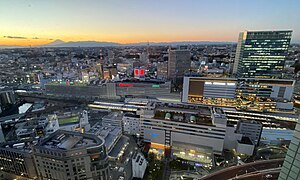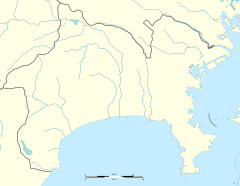Yokohama Station (横浜駅, Yokohama-eki) is a major interchange railway station in Nishi-ku, Yokohama, Japan. It is the busiest station in Kanagawa Prefecture and the fifth-busiest in the world as of 2013,[1] serving 760 million passengers a year.
 Yokohama Station viewed from above, January 2022 | |
| Japanese name | |
| Shinjitai | 横浜駅 |
| Kyūjitai | 橫濱驛 |
| General information | |
| Location | 1 Takashima (Keikyū) 2 Takashima (JR East) 1 Minami-Saiwai (Tokyu, Sotetsu, Subway) Nishi Ward, Yokohama City, Kanagawa Prefecture Japan |
| Coordinates | 35°27′57″N 139°37′22″E / 35.46583°N 139.62278°E |
| Operated by | |
| Connections | |
| History | |
| Opened | 7 May 1872 |
| Location | |
Lines
Yokohama Station is served by the following lines:
- East Japan Railway Company (JR East)
The Shōnan (train) Limited Express trains do not stop here.Sunrise Izumo and Sunrise Seto sleeper trains stop here for boarding and alighting passengers.
Morning Wing and Evening Wing trains pass this station.
(JR Central's Tokaido Shinkansen passes through Shin-Yokohama Station, not Yokohama Station.)
Station layout

Keikyu and JR East
The JR East and Keikyū platforms are located in the main above-ground portion of Yokohama Station. Keikyū's section consists of platforms 1 to 2, JR East operates platforms 3 to 10.
Keikyū introduced station numbering to its stations on 21 October 2010; Yokohama Station was assigned station number KK37.[2]
| 1 | KK Keikyū Main Line | for Kamiōoka, Yokosuka-chūō, Uraga, Miurakaigan, and Misakiguchi |
| 2 | KK Keikyū Main Line | for Keikyū Kamata, Haneda Airport (Terminal 3 and Terminal 1·2), Shinagawa, and Sengakuji A Toei Asakusa Line for Shimbashi, Asakusa and Oshiage KS Keisei Main Line for Keisei Funabashi, Keisei Narita, and Narita Airport (Terminal 2·3 and Terminal 1) KS Narita Sky Access Line for Narita Airport HS Hokusō Line for Imba Nihon-idai |
| 3 | JK Negishi Line | for Sakuragichō, Kannai, Ishikawachō, Isogo, and Ōfuna |
| 4 | JK Keihin-Tōhoku Line | for Tokyo, Ueno, Minami-Urawa, and Ōmiya |
| JH Yokohama Line | for Shin-Yokohama, Nagatsuta, Machida, Hashimoto, and Hachiōji | |
| 5-6 | JT Tōkaidō Line | for Totsuka, Ōfuna, Fujisawa, Chigasaki, Hiratsuka, Kōzu, Odawara, and Atami |
| Super View Odoriko/Odoriko for Izukyu-Shimoda and Shuzenji | ||
| □ Sleeper Ltd. Express Sunrise Izumo for Okayama and Izumoshi □ Sleeper Ltd. Express Sunrise Seto for Okayama and Takamatsu | ||
| 7-8 | JT Tōkaidō Line (Ueno-Tokyo Line) | for Kawasaki, Shinagawa, Shimbashi, Tokyo, Ueno, Ōmiya, Utsunomiya (via Utsunomiya Line), and Takasaki (via Takasaki Line) |
| 9 | JO Yokosuka Line | for Ōfuna, Kamakura, Yokosuka, and Kurihama |
| JS Shōnan-Shinjuku Line | Ōfuna, Fujisawa, Chigasaki, Hiratsuka, Kōzu, and Odawara (to the JT Tōkaidō Line) | |
| Ōfuna, Kamakura, and Zushi (to the JO Yokosuka Line) | ||
| 10 | JO Yokosuka Line | for Musashi-Kosugi, Tokyo, Tsudanuma, Chiba, Narita Airport (Terminal 2·3 and Terminal 1), Kimitsu, and Kazusa-Ichinomiya |
| ■ Narita Express for Narita Airport | ||
| JS Shōnan-Shinjuku Line | Shibuya, Shinjuku, Ikebukuro, Ōmiya, Utsunomiya (via Utsunomiya Line), and Takasaki (via Takasaki Line) |
- Central North gates to JR platforms
- Keikyu transfer gates
- Keikyu platform 1, 2015
- JR platforms 3 and 4
- JR platforms 5 and 6
- JR platforms 7 and 8
- JR platforms 9 and 10
Tokyu and Minatomirai
Tokyu Corporation and the Yokohama Minatomirai Railway Company share the same underground station located in the 5th underground level of Yokohama Station, to the west of the JR platforms.
| 1 |  Minatomirai Line Minatomirai Line | for Minatomirai and Motomachi-Chūkagai |
| 2 | TY Tōyoko Line | for Musashi-Kosugi, Jiyūgaoka, Naka-Meguro, and Shibuya F Fukutoshin Line for Shinjuku-sanchome, Ikebukuro, Kotake-mukaihara, and Wakoshi  Seibu Ikebukuro Line for Hannō Seibu Ikebukuro Line for HannōTJ Tōbu Tōjō Line for Shinrinkōen |
- Toyoko Line/Minatomirai Line ticket gates, April 2004
- Toyoko Line/Minatomirai Line platform, 2019
Yokohama Municipal Subway
The Yokohama Municipal Subway is located on the 3rd basement level, west of the main station.
| 1 |  Blue Line Blue Line | for Sakuragichō, Kannai, Kamiōoka, Shōnandai |
| 2 |  Blue Line Blue Line | for Shin-Yokohama, Center-Kita, and Azamino |
- Yokohama Municipal Subway station
Sotetsu
Sagami Railway is an above-ground structure to the west of the main station, connected to the Sotetsu Department Store.
| 1-3 |  Sotetsu Main Line Sotetsu Main Line | for Futamata-gawa, Yamato, Ebina, and Shōnandai |
- The Sotetsu platforms, February 2014

Bus services
Expressway bus (daytime)
- Yokohama City Air Terminal[3]
- Eastside bus terminal
- For Tokyo Disney Resort[6]
- For JR Gotemba Station (Mount Fuji), Hakone Tōgendai (Lake Ashi)[7]
Expressway bus (overnight)
- Yokohama City Air Terminal
- For JR Nagoya Station, JR Okayama Station[8]
- Eastside bus terminal
- For JR Kyoto Station, JR Ōsaka Station, JR Sendai Station, JR Akita Station[8]
Local routes
Surrounding area

The west and east have a complex underground business district which spans over several floors and is directly connected with the buildings which surround the station. Yokohama station has three bus terminals, and two other bus terminals are located near the station.
East entrance

- Porta (underground shopping mall)
- Sogo (department store, with Yokohama station eastside bus terminal)
- Lumine (shopping building)
- Kiyoken
- Marui (0101) (department store)
- Yokohama Sky Building (with Yokohama City Air Terminal, and its bus terminal)
- Bay Quarter Yokohama (shopping center)
- Yokohama Plaza Hotel
- Yokohama Central Post Office
- The Port Service Yokohama Station East Exit pier
- Horizon Japan International School (HJIS) Yokohama
West entrance

- The Diamond (underground shopping mall, and stairs to westside bus terminal)
- Takashimaya (department store)
- CIAL (shopping building : under construction)
- Sotetsu Joinus (shopping building)
- Sotetsu Movil 109 cinemas
- Yokohama station westside second bus terminal
- Yokohama Cinema Society
- Yokohama Excel Hotel Tokyu (under construction)
- Yokohama Bay Sheraton Hotel and Towers
- Yokohama More's (shopping building, with Tokyu Hands Yokohama store)
- Yodobashi Camera Yokohama store
- Bic Camera Yokohama store
- Vivre (shopping building)
- Daiei (supermarket)
- NTT Yokohama East Building
History
First station
On 7 May 1872 (12 June in Gregorian calendar), Yokohama Station (original station, now Sakuragichō Station) opened as one of the first railway stations in Japan.
On 11 July 1887, the railway was extended from Yokohama to Kōzu Station. Through trains between Shimbashi Station and Kōzu Station required a switchback at Yokohama Station.On 1 August 1898, a line bypassing Yokohama Station was opened to avoid the switchback. Through trains stopped at Kanagawa Station or Hodogaya Station instead of Yokohama Station, and shuttle trains connected Yokohama and Hodogaya until Hiranuma Station opened near present-day Hiranumabashi Station on 10 October 1901.[13] Hiranuma Station had no connection to public transport such as trams, so that major part of the passengers for the city continued to use trains that stopped at Yokohama Station.[14]
Second station

On 15 August 1915, the second Yokohama Station opened close to the present day Takashimachō Station to allow Tōkaidō Main Line trains to call at Yokohama Station. The original Yokohama Station was renamed Sakuragichō Station. JR East uses this date as the opening date of the current Yokohama Station.[15]The terminal of the Keihin Line (present-day Keihin-Tōhoku Line) had been in Takashimachō since 1914 and was merged with the new station. The government-run electric line was later that year extended to Sakuragichō.
On 1 September 1923, the station was destroyed by a fire in the 1923 Great Kantō earthquake.Six days later, the station reopened with a temporary building.The city of Yokohama and the Ministry of Railways agreed in February 1924 that the station would be relocated.[16]
On 18 May 1928, the Tokyo Yokohama Railway (now the Tokyu Toyoko Line) was extended from its former terminal at Kanagawa Station to the station. The extension line passed through the construction site of the new Yokohama Station of the government railways.[17]
Third station


On 15 October 1928, the third (current) Yokohama Station opened on the north side of the second station. The Tōkaidō Main Line also moved to its current route, which was the route of the bypass line opened in 1898. The government railways and the Toyoko Line shared the station from the beginning.[18]On 5 February 1930, the Keihin Electric Railway (now the Keikyu Main Line) was connected to the station.On 27 December 1933, the Jinchū Railway (now the Sotetsu Main Line) was connected to the station. On 9 December 1957, the north side underground entrance opened. On 1 December 1965, the MARS on-line ticket reservation system was introduced at the station. On 4 September 1976, the Yokohama City Subway Line No. 3 was connected to Yokohama Station. On 7 November 1980, the new east station building and east-west passage opened. On 31 January 2004, The Tōkyū Tōyoko Line platform reopened underground, and on 1 February 2004, the Minatomirai Line opened.
2020
On 26 August 2010, JR East announced the development of a new station building to replace the current West Entrance, tentatively named the Yokohama Station West Station Building (横浜駅 西口駅ビル, Yokohama-eki Nishiguchi-eki biru).[19] It opened in 2020 before the Tokyo 2020 Summer Olympics. The development includes a 26-story retail and office building, Station-front tower (駅前棟, Ekimae-tō), on the site of the current West Entrance and a nine-story building to the north-east, Tsuruya-cho tower (鶴屋町棟, Tsuruyamachi-tō), which includes parking and childcare facilities.[20]
Passenger statistics
In fiscal 2013, the JR East station was used by an average of 406,594 passengers daily (boarding passengers only), making it the busiest JR East station in Kanagawa Prefecture and the fourth-busiest on the JR East network as a whole.[21]
The JR East passenger figures for previous years are as shown below.
| Fiscal year | Daily average |
|---|---|
| 2000 | 385,023[22] |
| 2005 | 384,594[23] |
| 2010 | 398,052[24] |
| 2011 | 394,900[25] |
| 2012 | 400,655[26] |
| 2013 | 406,594[21] |
See also
References
External links

- JR-East Yokohama Station information
- Keikyu Railway Train and Bus information Archived 2017-04-26 at the Wayback Machine
- Tokyu Railway information
- Yokohama Minatomirai railway information
- Sōtetsu Line Yokohama Station Map
- Transportation Bureau, City of Yokohama (Municipal Subway and Bus) Archived 2011-02-17 at the Wayback Machine


















